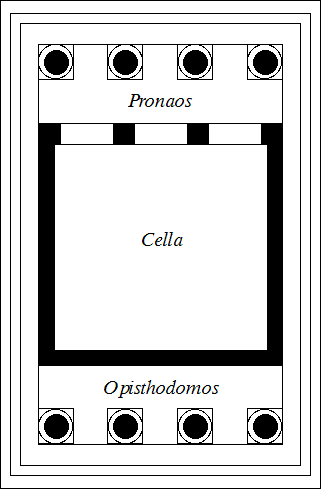The Temple of Athena Nike stands on the parapet of the Acropolis, to the southwest and to the right of the Propylaea. The architect Kallikrates, who was one of the two architects of the Parthenon, built the temple from 427 to 425 BCE. The temple is a small Ionic temple that consists of a single naos, where a cult statue stood fronted by four piers. The four piers aligned to the four Ionic prostyle columns of the pronaos . Both the pronaos and opisthodomos are very small, nearly non-existent, and are defined by their four prostyle columns.

Plan of the Temple of Athena Nike
Plan of the Temple of Athena Nike. Ca. 427-425 BE.

Temple of Athena Nike
Temple of Athena Nike. Marble. Ca. 427-425 BCE. Acropolis, Athens, Greece.
The continuous frieze around the temple depicts battle scenes. Unlike the metopes of the Parthenon, which depict mythical battles, the battles shown on the frieze of the Temple of Athena Nike depict historical battles of the Greeks. These representations include battles from the Persian and Peloponnesian Wars, including a cavalry scene from the Battle at Marathon and the Greek victory over the Persians at the Battle of Plataea. The scenes on the Temple of Athena Nike are similar to the battle scenes on the Parthenon, which represented Greek dominance over non-Greeks and foreigners in mythical allegory. The scenes depicted on the frieze of the Temple of Athena Nike frieze display Greek and Athenian dominance and military power throughout historical events.
A parapet was added on the balustrade to protect visitors from falling down the steep hillside. Images of Nike, such as the famous depiction of Nike adjusting her sandal , are carved in relief. In this scene Nike is portrayed standing on one leg as she bends over a raised foot and knee to adjust her sandal. Her body is depicted in the new High Classical style. Unlike Archaic sculpture, this scene actually depicts Nike's body. Her body and muscles are clearly distinguished underneath her clothing. Her clothing appears transparent with deep heavy folds in a style known as wet drapery. This style allows sculptors to depict the body of a woman while still preserving the modesty of the female figure. Although Nike's body is visible, she remains fully clothed. This style is found elsewhere on the Acropolis, such as on the Caryatids and on the women in the Parthenon's pediment.

Nike Adjusting Her Sandal
Nike adjusting her sandal. Marble. Ca. 425-420 BCE. Temple of Athena Nike, Acropolis, Athens, Greece.